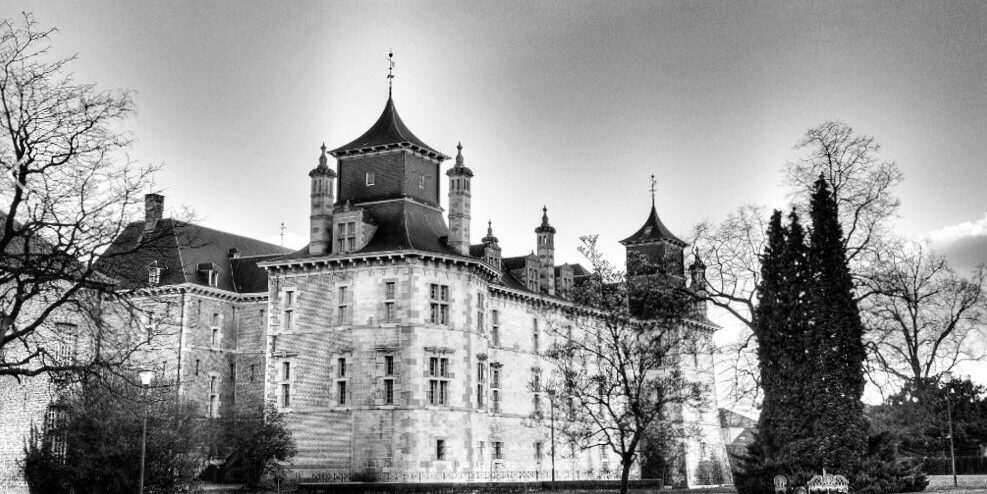Reckheim, now Rekem, is located on the Maas in Belgian Limburg, not far north of Maastricht. The oldest known lord of the Rekem manor is Arnold van Rekem (1108). The Reckheim manor became a free barony in 1356. On March 31, 1623, the free barony of Reckheim was elevated to Imperial count by Emperor Ferdinand II. In addition, the right to mint gold, silver and copper coins was also reiterated. Just like the imperial cities (including Deventer, Kampen and Zwolle), Reckheim was directly under the authority of the Holy Roman Empire. The earliest coins of Reckheim date back to the 14th century, this first coinage was in the name of the lords of Stein. The county of Reckheim was a mini-state consisting of the villages of Rekum, Uikhoven and Boorsem and the hamlets of Kotem, Halle, Geneut and Weset (now Veld-Wezelt).
The county Rijckholt was also in the possession of the Count of Reckheim for some time since January 10, 1596. On this date he bought the manor from Willem van Vlodrop. Some time later it came back into the possession of the van Vlodrop family. In 1631, the county consisted of about 160 houses, so we should not be too big on the size. Nevertheless, they succeeded in flooding the then Netherlands with mainly copper change. The enormous quantities that have been minted and the execution of the different types can only indicate one thing: they were beaten for export elsewhere. After all, the county was small, so there was no market. Most minted types also did not match the coins that were in circulation in the region around Reckheim.
The run-up to the later large-scale coins was when Reckheim (then still Baronie) came into the possession of Herman van Aspremont-Lynden (baron from 1590-1603) in 1590. He was the son of Thiery van Aspremont-Lynden and Marie van Elderen. Herman had exchanged Reckheim with Willem Quadt van Wijkradt who got his German possessions in return. Among other things, Zobbenbroek with many vineyards in Bacharach on the Rhine. Besides Baron van Reckheim, he also called himself Baron van Boorshem. He was also Baron van Rijckholt, Lord of Houtain-St. Simeon, Once-sur-Geer, Tongrenelle, Wanfercée-Baulet and Crenwyck. He was married to Marie van Hamal. Emperor Rudolf II (1576-1612) granted Herman all the old rights and privileges, including the right to mint. He also declared the barony hereditary in both the male and the female line. In 1595 Herman had the old ruined castle demolished completely and rebuilt from scratch. After his death in 1603, his son Ernestus, born in 1583, succeeded him as baron.
Ernestus called himself Free Baron of Reckheim, Boorsem and Rijckholt. In 1609 he married Anne Antoinette Gouffier (* 1580 – † 1620) with whom he had four children, a son and three daughters. She was Lady of Thiennes and her father was Henri Gouffier, Lord of Crèvecoeur. Her bedside great-grandfather was married to Philippe de Montmorency, Lady of Vitry-en-Brie, daughter of Jean II Lord of Montmorency. It is therefore possible that small eagles from the Montmorency coat of arms were also used on Reckheim coins. Ernestus was a diplomat and favored future Emperor Ferdinand II (1619-1637). On March 31, 1623, Reckheim was promoted to county by this emperor and the right to mint gold, silver and copper coins was reaffirmed. In the same year Ernestus received the skull of Saint Petronella. In order to preserve it in a dignified manner, he had a new chapel built. From 1625 to 1630 he had the village of Rekem completely walled, complete with two entrance gates. In 1635 a second wall was built within the 1st. All these construction activities will undoubtedly have influenced the coinage. Ernestus will have partly paid for the money that was needed for these activities from the proceeds of the coin. We see an increased activity in coinage in the period 1620-1636. The copper price was also very favorable in these years, which contributed significantly to making a profit. In 1626 the price of Swedish copper on the Amsterdam staple market was still 64 guilders per 100 pounds. In the 1930s, the price dropped to 50 guilders per 100 pounds, while the weight and value of issue of the copper ore did not change. Only after 1650 did the price of copper start to rise again.
A very eventful period of impersonation took place during the reign of Ferdinand D’Aspremont-Lynden (* 1611 – † 1665). After the death of his father Ernestus in 1636, he acquired the county. He also inherited the baronies of Thiennes and Steenbeek and the manors of Blaringen, Houtain-St. Simeon and Once-sur-Geer. Rijckholt no longer occurs and must therefore have been transferred to the Vlodrop family before 1636. Ferdinand married Isabel Countess of Fürstenberg-Heiligenberg in 1643 who gave him 16! children. Like his father, he continued to collect copper money en masse. He continued coin types minted by his father and introduced some new ones. He also started again copying mainly liards of the principality of Liège and southern Dutch liards.
Many imitations have been put together in such a way that if people had complaints about the Reckheim coin, they could immediately give a defense. The sculpture was often very ingeniously composed and closely resembled the original copies. Often only money changers and calculators could distinguish the Reckheim imitations from the real ones. The introduction of these coins was partly possible because in the past most people could not read and therefore could not read the inscriptions on the coins. The profit that the lords of Reckheim achieved with their coinage arose because the appearance of the coins was copied, but not the content and weight. For example, many Reckheim’s pennies weighed only less than half that of a good specimen, while the silver coins contained too high a copper percentage. It is therefore not surprising that Reckheim received complaints about the coinage. After 1650, under Maximilian of Bavaria (1650-1688), places of a new type were even introduced in Liège, because the old ones were hardly accepted anymore because of the many forgeries. In 1652 a commission of inquiry was formed by Emperor Ferdinand III (1637-1657) and anyone who had a dispute with Reckheim was sued. For example, Liège complained that the count imitated coins with their sovereign’s coat of arms on them. The Count of Reckheim defended himself by pointing out his right to mint coins. Both in his castle at Reckheim and in his manor Weset. However, the count will have omitted the coinage of these types after this date. From a trial in Groningen in 1659 against a certain Dirk Hamer, the count of Reckheim stated in writing that the stamps for his pennies had been cut by the stamp cutter of the episcopal coin in Liège. Something I don’t think would have happened if he still hit Liège imitations. The production of pennies and places following the example of northern Dutch pieces will have been a safer activity for Ferdinand. People could complain about his coins, but there was not much that could be done about it. Reckheim was far away in the southern Netherlands and was protected by the German emperor.
Count Ferdinand died in 1665, but his children were still minors. Bishop Frans Egon of Fürstenberg, Count Ferdinand’s brother-in-law, and Isabelle Henriette d’Aspremont-Lynden, Princess Abbess of Munsterbilzen, were appointed guardians until one of the children came of age. Frans Egon van Fürstenberg was an important figure in the area of the Principality of Liège and the surrounding area. Together with his brother Willem Egon, he had a great influence on Maximilian of Bavaria, nephew and successor of Prince-Bishop Ferdinand of Bavaria. Maximilian had little interest in ruling the prince-bishopric and led a secluded life as an alchemist. He left the government largely to the two brothers Frans Egon and Willem Egon. They headed a long list of manors and abbeys, including that of Stavelot. The German emperor made them princes in 1644. Frans Gobert van Aspremont-Lynden was Count Ferdinand’s eldest son and took over the reign in 1673 when he came of age. His uncle Frans Egon had provided him with many profitable ecclesiastical titles. Because Frans Gobert was a clergyman he could not officially have children so the rights to the county were transferred to his brother Ferdinand Gobert. Frans Gobert, however, ruled the county in his name. It is noticeable that many sons have the nickname Gobert and the daughters the name Gobertina. This name was to honor an ancestor, Gobert of Aspremont, monk of Villers and crusader.
In the northern provinces, the coins (and places) minted in Reckheim circulated alongside the official copper coins. Most imitations come from the duit and places of Friesland, Utrecht and some cities duiten. In 1702, however, the Province of Holland was the first to introduce a new type of duit which was larger and heavier than the old duit. Henceforth only these pennies were allowed to circulate and the old and foreign pennies were reduced in value to half a penny. All other provinces now started to mint the new and heavier pennies since 1702. Due to the better execution due to the use of the screw press and the heavier weight, it no longer made sense for Reckheim to hit inferior money.
Heraldry on Reckheim Coins
Many weapons have been used on the coins of Reckheim, which sometimes cannot all be explained properly. Because attempts were often made to imitate a particular currency, various coats of arms of family members and in-laws were used in various compilations. It is often impossible to discover a certain unity in it. The coat of arms of Rekem and the coats of arms of the d’Aspremont-Lynden family are clear and easy to find. The coat of arms of Rekem and the county of the same name was a red clawed lion facing left on gold. Furthermore, the weapon was supplemented with the weapons of the owner at that time. For example, the coat of arms of Rekem under the d’Aspremont-Lynden family was supplemented with the coat of arms of Lynden, a gold cross on red, and with a silver eagle on blue of Este (related to d’Aspremont). The coat of arms was held by 2 greyhounds.
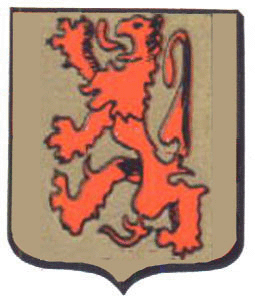
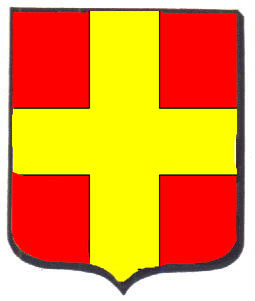
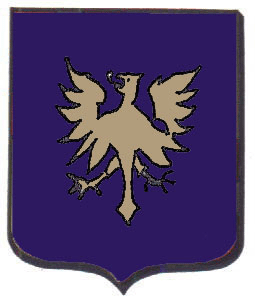
Rekem Lynden d`Aspremont
By marrying women from important families, the Counts of Reckheim obtained new weapons and titles that they used on their coins. Sometimes it is necessary to look very far back to find a (family) relationship with a used (family) coat of arms. Count Ernestus used a shared crest on his liards with Lynden’s cross on the left. If it concerns an alliance weapon, the weapons on the right come from his wife Anne Antoinette Gouffier. She was lady of Thiennes and her father was Henri Gouffier, lord of Crèvecoeur. The top coat of arms that appears on these liards is Gouffier’s coat of arms consisting of black bars on gold. The bottom coat of arms is that of Montmorency. Her bedside great-grandfather was married to Philippe de Montmorency, Lady of Vitry-en-Brie, daughter of Jean II Lord of Montmorency. Possibly that is why small eagles from the Montmorency coat of arms were also used on Reckheim coins. I have not yet been able to discover another family connection with Montmorency.
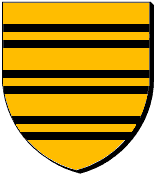

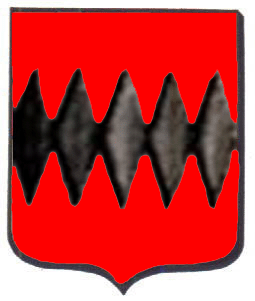
Imitations of Liards from Liards have a diamond motif which is often described as Stein’s coat of arms. Ernestus’ mother, however, was Marie of Hamal, whose family had a diamond pattern in the coat of arms which lent itself well to imitate the coat of arms of Bavaria. The mother of Herman van Aspremont-Lynden (baron from 1590-1603) was Marie van Elderen. I don’t think the van Elderen coat of arms was used on the copper coins of Reckheim. The coat of arms consisted of a golden bar with above and below so-called blue vair bells. Vair was the name for the very expensive lining of clothes made from the fur of the gray squirrel.

